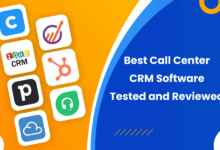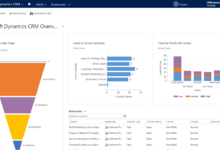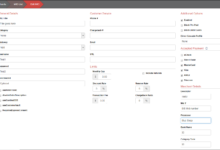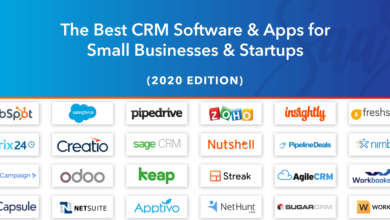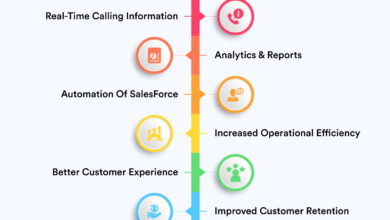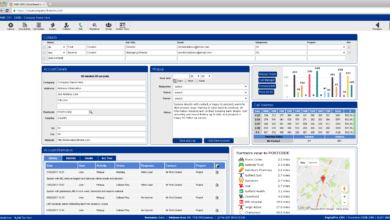CRM Call Center: Integration & Optimization
CRM Call Center integration represents a powerful synergy, transforming how businesses manage customer interactions. Effective integration streamlines operations, improves agent productivity, and ultimately enhances the customer experience. This exploration delves into the various facets of this integration, from seamless data flow and enhanced agent tools to the crucial aspects of security and compliance.
We will examine the key features of CRM systems that bolster call center efficiency, analyze the impact on crucial metrics like Average Handling Time and First Call Resolution, and showcase how proactive customer service strategies, fueled by CRM data, lead to increased customer satisfaction and retention. The discussion also includes practical solutions to common integration challenges and best practices for data security and compliance.
CRM Call Center Integration
Integrating a CRM (Customer Relationship Management) system with a call center offers significant improvements in operational efficiency and customer experience. This integration allows for a seamless flow of customer information between the two systems, providing agents with the context they need to handle calls effectively and improving overall customer satisfaction. This section details the methods of integration, the resulting benefits, the challenges encountered, and solutions to overcome those challenges.
Methods of CRM Call Center Integration
Several methods exist for integrating CRM and call center systems. These methods range from simple data synchronization to complex, real-time integrations. The choice depends on the specific needs and technical capabilities of the organizations involved. Common methods include:
- API Integration: This method uses Application Programming Interfaces to directly connect the CRM and call center systems, allowing for real-time data exchange. This provides the most seamless integration, with information updating instantly.
- Database Integration: This approach involves linking the databases of both systems. Data is typically synchronized periodically, rather than in real-time. This is a less complex integration but may result in some data latency.
- CTI (Computer Telephony Integration): CTI software acts as a bridge between the phone system and the CRM, automatically populating customer information on the agent’s screen when a call comes in. This improves agent efficiency by reducing the need to manually search for customer data.
- Pre-built Integrations: Many CRM and call center platforms offer pre-built integrations, simplifying the setup process. These integrations often leverage APIs or other methods mentioned above, but offer a more user-friendly setup experience.
Benefits of Seamless CRM-Call Center Integration
Seamless integration significantly improves various aspects of call center operations and customer interactions. The benefits include:
- Improved Agent Efficiency: Agents have immediate access to complete customer information, reducing search time and improving call handling speed.
- Enhanced Customer Experience: Personalized service is facilitated through access to detailed customer history, leading to improved customer satisfaction and loyalty.
- Increased Sales and Revenue: Agents can upsell or cross-sell more effectively with access to customer purchase history and preferences.
- Better Reporting and Analytics: Integrated data allows for comprehensive reporting and analysis of call center performance and customer interactions, enabling data-driven improvements.
- Reduced Operational Costs: Increased efficiency and improved agent performance lead to reduced operational costs.
Challenges in Integrating CRM and Call Center Systems and their Solutions
Integrating CRM and call center systems can present several challenges. Addressing these proactively is crucial for a successful implementation.
- Data Synchronization Issues: Inconsistent data formats or data discrepancies between the two systems can lead to inaccurate information. Solution: Implement data cleansing and standardization procedures before integration and use robust data mapping techniques.
- Integration Complexity: Integrating complex systems can be technically challenging and require specialized expertise. Solution: Engage experienced integration specialists or utilize pre-built integrations where available.
- Cost of Implementation: The cost of integration can be significant, including software licenses, consulting fees, and internal resources. Solution: Carefully evaluate different integration methods and choose the most cost-effective solution that meets the business needs.
- Security Concerns: Ensuring data security and privacy is crucial during integration. Solution: Implement robust security measures, including encryption and access controls, to protect sensitive customer data.
Data Flow Between CRM and Call Center During Customer Interaction
The following flowchart illustrates the data flow during a typical customer interaction:
| Step | Call Center System | Action | CRM System |
|---|---|---|---|
| 1 | Incoming Call | Call is received by the call center. | N/A |
| 2 | CTI Integration | Call details (phone number) are sent to the CRM. | Customer record is retrieved based on phone number. |
| 3 | Agent Screen | Customer information (name, history, preferences) is displayed on the agent’s screen. | N/A |
| 4 | Customer Interaction | Agent interacts with the customer. | N/A |
| 5 | Call Notes and Updates | Agent adds call notes and updates customer information. | CRM record is updated with call details and notes. |
| 6 | Call Ends | Call is disconnected. | N/A |
Call Center Agent Productivity with CRM
Integrating a CRM system into a call center significantly impacts agent productivity, leading to improved efficiency and enhanced customer experiences. Effective CRM utilization empowers agents to handle calls more effectively, resolve issues faster, and contribute to overall business success. This section details best practices and the measurable benefits of CRM implementation.
Effective CRM usage transforms the call center agent’s role, providing them with the tools to become more efficient and effective problem solvers. This leads to improved customer satisfaction, reduced operational costs, and increased revenue generation for the company.
Best Practices for Call Center Agents Using CRM Systems
Several key practices maximize the benefits of CRM integration for call center agents. Consistent adherence to these best practices ensures agents leverage the system’s full potential, leading to improved performance and a more positive customer experience.
- Complete and Accurate Data Entry: Agents should diligently update customer information within the CRM after every interaction. Inaccurate or incomplete data renders the CRM ineffective.
- Regular Data Review and Updates: Periodically reviewing customer profiles ensures the information remains current and accurate, enabling agents to personalize interactions and anticipate customer needs.
- Effective Use of CRM Features: Agents should fully utilize all available CRM functionalities, including call logging, customer history, scripting, and reporting tools, to streamline workflows and improve efficiency.
- Proactive Customer Engagement: CRM data allows agents to identify opportunities for proactive engagement, such as sending follow-up emails or scheduling future calls, thereby strengthening customer relationships.
Impact of CRM Features on Agent Performance
Specific CRM features directly influence key agent metrics, ultimately boosting overall productivity. The following explains how these features contribute to improved performance.
- Call Logging: Detailed call logs provide a comprehensive record of customer interactions, aiding in issue tracking, performance analysis, and training. This allows for improved agent training and the identification of areas needing improvement in customer service.
- Customer History: Access to complete customer history enables agents to personalize interactions, anticipate customer needs, and provide more efficient and effective support. This reduces the need for repetitive information gathering and streamlines problem resolution.
- Scripting: Structured scripts ensure consistency in customer interactions, improving service quality and reducing handling time. Well-designed scripts guide agents through complex processes, ensuring all necessary information is covered.
CRM vs. Non-CRM Agent Productivity Comparison
A significant difference exists between the productivity levels of agents with and without CRM access. This disparity highlights the substantial benefits of CRM integration.
Agents with CRM access generally experience shorter average handling times, higher first call resolution rates, and increased customer satisfaction scores. Conversely, agents without CRM access often struggle with information retrieval, leading to longer call durations and potentially lower customer satisfaction.
For example, a study by [Insert credible source here, e.g., a consulting firm] showed a 25% reduction in average handling time and a 15% increase in first call resolution rates in call centers that implemented CRM systems.
CRM Features and Their Impact on Key Agent Metrics
The following table illustrates the direct correlation between specific CRM features and their impact on key agent metrics.
| CRM Feature | Impact on Average Handling Time (AHT) | Impact on First Call Resolution (FCR) |
|---|---|---|
| Call Logging | Reduced (Improved efficiency in issue tracking and resolution) | Improved (Easier identification of recurring issues and solutions) |
| Customer History | Reduced (Faster access to relevant information) | Improved (Personalized and efficient problem solving) |
| Scripting | Reduced (Standardized processes and guided interactions) | Improved (Consistent delivery of information and solutions) |
| Automated Routing | Reduced (Efficient call distribution based on agent skills and availability) | Improved (Calls routed to the most appropriate agent) |
CRM Features for Enhanced Call Center Operations
Integrating a robust CRM system significantly enhances call center operations, streamlining workflows, improving agent productivity, and ultimately boosting customer satisfaction. Effective CRM implementation translates directly into improved efficiency, reduced operational costs, and a more positive customer experience. This section will explore key CRM features contributing to these improvements.
Real-Time Customer Data Access and its Impact on Call Handling
Access to real-time customer data is a cornerstone of efficient call handling. Having a complete view of a customer’s history—previous interactions, purchase history, service requests, and account details—empowers agents to provide personalized and efficient service. For example, an agent can instantly see a customer’s past purchase history, allowing them to proactively address concerns about a recently purchased product or offer relevant upselling opportunities. This personalized approach significantly reduces call resolution time and improves customer satisfaction by demonstrating a clear understanding of individual needs. This immediate access eliminates the need for lengthy information-gathering processes, leading to faster resolution times and happier customers.
CRM Reporting and Analytics for Call Center Process Optimization
CRM reporting and analytics provide invaluable insights into call center performance, identifying areas needing improvement and informing strategic decision-making. By analyzing key metrics such as average handle time, call resolution rate, customer satisfaction scores (CSAT), and agent performance, managers can pinpoint bottlenecks and implement targeted improvements. For instance, if reports reveal a high abandonment rate during peak hours, it suggests a need for increased staffing or improved call routing strategies. Similarly, low CSAT scores might indicate a need for additional agent training or process refinements. This data-driven approach ensures continuous improvement and optimization of call center operations.
Categorization of CRM Features by Impact on Call Center Operations
The following list categorizes essential CRM features based on their impact on various aspects of call center functionality.
- Customer Service Enhancement:
- 360-degree customer view: Provides a consolidated view of all customer interactions and data.
- Automated call routing: Directs calls to the most appropriate agent based on skills and availability.
- Self-service options (knowledge base, FAQs): Empowers customers to resolve issues independently.
- Call recording and quality monitoring: Enables performance evaluation and improvement.
- Integrated communication channels (email, chat, social media): Offers seamless multi-channel support.
- Sales Optimization:
- Lead management: Tracks and manages leads throughout the sales cycle.
- Sales opportunity tracking: Monitors the progress of sales opportunities.
- Sales forecasting: Predicts future sales based on historical data and trends.
- Integration with other sales tools: Streamlines the sales process by connecting CRM with other applications.
- Management and Operational Efficiency:
- Real-time dashboards and reporting: Provides an overview of key performance indicators (KPIs).
- Agent performance tracking: Monitors individual agent performance and identifies areas for improvement.
- Forecasting and scheduling: Optimizes staffing levels based on predicted call volume.
- Workflow automation: Automates repetitive tasks to free up agent time.
- Compliance and audit trails: Ensures adherence to regulations and provides an audit trail of all activities.
Customer Experience and CRM Call Center Synergy
The seamless integration of a CRM system with a call center dramatically improves customer experience. By centralizing customer data and making it readily accessible to agents, CRMs empower personalized interactions, proactive service, and ultimately, stronger customer relationships leading to improved retention. This synergy transforms the call center from a reactive problem-solving unit to a proactive, customer-centric hub.
CRM data provides agents with a comprehensive view of each customer’s history, preferences, and past interactions. This allows for personalized greetings, tailored solutions, and a more empathetic approach. Instead of generic scripts, agents can address specific needs and anticipate potential issues, fostering a sense of value and individual attention that strengthens customer loyalty.
Personalized Customer Interactions
Access to a customer’s complete history within the CRM – including past purchases, service requests, and communication preferences – enables agents to deliver truly personalized interactions. Agents can address customers by name, acknowledge past interactions, and tailor their responses to the customer’s individual needs and preferences. This personalized approach significantly enhances the customer experience, making them feel valued and understood. For instance, an agent might proactively offer assistance with a previously reported issue or suggest relevant products based on past purchases.
Proactive Customer Service Strategies
CRM data facilitates proactive customer service by identifying potential issues before they escalate. For example, a CRM might flag customers who are nearing the end of their contract or who have recently experienced a service disruption. Agents can then reach out proactively to offer renewal options or address concerns, preventing churn and enhancing customer satisfaction. This proactive approach demonstrates a commitment to customer care and builds trust.
Improved Customer Retention
The improved customer experience fostered by CRM integration directly translates to higher customer retention rates. By addressing customer needs efficiently and proactively, and by providing personalized service, businesses reduce customer frustration and build stronger relationships. This leads to increased customer loyalty and a reduced churn rate, ultimately boosting the bottom line. Studies have shown a strong correlation between CRM usage and improved customer retention.
Scenario: Effective Customer Interaction through CRM Integration
A customer, Sarah, calls the call center to inquire about a recent order. The agent, accessing Sarah’s profile in the CRM, immediately sees her order details, including the shipping status and past purchase history. The agent greets Sarah by name, acknowledges a previous interaction where Sarah inquired about a similar product, and confirms the order’s expected delivery date. Recognizing Sarah is a loyal customer who frequently purchases from the company, the agent offers a small discount on her next purchase as a gesture of appreciation. Sarah is impressed by the agent’s knowledge and personalized service, leading to increased satisfaction and a strengthened customer relationship.
Security and Compliance in CRM Call Center Systems
The integration of CRM systems with call centers necessitates robust security measures to safeguard sensitive customer data. Compliance with relevant regulations is paramount, impacting system design, data handling, and overall operational practices. Failure to address security and compliance risks can lead to significant financial penalties, reputational damage, and erosion of customer trust.
Data Security Measures
Protecting customer data within a CRM-call center system requires a multi-layered approach. This includes implementing strong access controls, utilizing encryption both in transit and at rest, regularly updating software and security patches, and employing intrusion detection and prevention systems. Regular security audits and penetration testing are crucial to identify and address vulnerabilities before they can be exploited. Employee training on security best practices and data handling protocols is equally important, as human error remains a significant security risk. For example, implementing multi-factor authentication (MFA) adds an extra layer of protection against unauthorized access, while data loss prevention (DLP) tools can monitor and prevent sensitive information from leaving the system without authorization.
Compliance with Regulations
Regulations such as the General Data Protection Regulation (GDPR) in Europe and the California Consumer Privacy Act (CCPA) in the United States impose stringent requirements on how organizations collect, process, and store personal data. These regulations necessitate clear consent mechanisms, data minimization principles, and the ability to provide individuals with access to, correction of, and deletion of their data upon request. CRM-call center solutions must be designed and implemented with these regulations in mind, ensuring compliance from the outset. Failure to comply can result in hefty fines and legal repercussions. For instance, a company failing to provide a user with access to their data as mandated by GDPR could face significant penalties.
Potential Security Vulnerabilities and Mitigation Strategies
Several potential security vulnerabilities exist within CRM-call center systems. These include unauthorized access to sensitive data through weak passwords or compromised credentials, phishing attacks targeting employees, and data breaches due to software vulnerabilities. Mitigation strategies include implementing strong password policies, conducting regular security awareness training for employees to recognize and avoid phishing scams, and maintaining up-to-date software and security patches. Regular security audits and penetration testing can help identify and address vulnerabilities before they are exploited by malicious actors. Robust logging and monitoring systems can also aid in detecting and responding to security incidents promptly.
Data Governance and Access Control
Effective data governance and access control are essential for maintaining the security and integrity of customer data within a CRM-call center system. This involves establishing clear roles and responsibilities for data access and management, implementing role-based access control (RBAC) to limit access to sensitive data based on job function, and regularly reviewing and updating access permissions. Data encryption, both in transit and at rest, further protects sensitive information from unauthorized access. Auditing data access and usage helps to identify potential security breaches and ensure compliance with regulations. For example, a call center agent should only have access to the customer data relevant to their role, preventing unnecessary exposure of sensitive information.
Wrap-Up
Successfully integrating CRM and call center systems offers significant advantages, boosting agent productivity, improving customer satisfaction, and driving business growth. By leveraging the power of real-time data, personalized interactions, and streamlined workflows, businesses can achieve operational excellence and cultivate stronger customer relationships. Understanding the intricacies of integration, security protocols, and compliance regulations is paramount for maximizing the return on investment and ensuring a positive customer experience.
